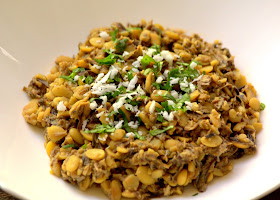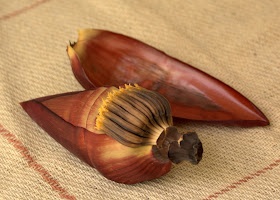Last few days have been full of frenzy. Husband sprained his ankle while playing tennis and isn't allowed to move his leg for a few weeks. It's been crazy running a one man show. While he spent most of the week sitting in one place under a 'house arrest' (in his words), I've been managing all the 'man' activities on top of my regular chores. Hubs feels guilty making me run around to get things done, but I'm mostly worried about his recovery. He is bored out of mind sitting around not doing anything. And I realize how many things I don't have to worry about when he's taking care of them. I thought a nice meal would add some excitement to his boring schedule. Our new patio furniture was delivered just in time for this lovely meal. Hubby quite enjoyed eating out in the yard, admiring all the plants I've been taking care of in his absence :).
I made a nice paneer gravy for hubs - my usual choice for a 'special' meal. While most tomato-based paneer gravies taste similar, I chose to make Paneer Tikka Masala this time. Paneer Tikka, which is grilled paneer marinated in yogurt and spices, is loved widely. This dish turns the dry grilled paneer dish into a gravy. The curry base is pretty generic, but grilled paneer adds a more robust flavor. My favorite part of the gravy is karusi methi (dried fenugreek leaves) which adds plenty of fragrance and slight bitterness that balances all the tang really well. My version didn't turn that deep red color you see at the restaurants. There is nothing fancy about it - restaurants use food color which I don't care for much. We ate the Paneer Tikka Masala with parathas. I turned the leftovers into a pizza - a great way to use up all that goodness.
Marinade:
8oz. Paneer - cut into ~ 3/4' cubes
1/2 Cup yogurt
1 Teaspoon cumin-coriander powder
1 Teaspoon red chili powder
1/2 Teaspoon chaat masala/aamchur
1 Teaspoon ginger-garlic paste
Salt to taste
Gravy:
2 Large tomatoes (or 1/4 cup tomato paste)
1/2 Small onion
2 Teaspoons ginger-garlic paste
1 Tablespoons kasuri methi (dried fenugreek leaves)
1/4 Cup green peas (alternatively, you can add chopped green bell peppers)
1/2 Teaspoon (or to taste) garam masala
Red chili powder to taste
1 Teaspoon sugar
Salt to taste
Cream/butter - optional
Water as needed
Tempering:
1 Tablespoon oil
1/2 Teaspoon cumin seeds
1 Large bay leaf
1 Inch stick of cinnamon
1 Star anise
1/4 Teaspoon turmeric powder
Pinch of asafoetida
- Whisk together all the ingredients for the marinade and marinate paneer cubes for ~30 mins.
- Puree onions and tomatoes while paneer marinates. If you don't want to puree onions, chop them finely.
- Once paneer is marinated, heat a shallow pan and drizzle some oil. Remove excess marinade from the paneer cubes and shallow fry them (keep the extra yogurt). Turn the paneer so all the sides turn golden brown. If you have a small grill or a griddle pan, you can grill the paneer cubes for a nice charred flavor. Keep the paneer aside.
- Heat a tablespoon of oil in a kadhai and add cumin seeds. Once they splutter, add bay leaf, cinnamon and star anise. Let the spices get fragrant.
- Add asafoetida, turmeric, and ginger-garlic paste and fry for a few seconds.
- Add tomato-onion puree, garam masala, red chili powder (I suggest adding very little at the beginning since paneer also has some), and sugar to the tempering. Sugar will balance the tang of tomatoes. Roast this paste on medium for a good 5-7 minutes, stirring constantly.
- Stir in the leftover yogurt marinade, kasuri methi, peas or green bell pepper, and paneer cubes, and cook for another 2-3 minutes. The yogurt will add creaminess.
- You can add more spices and salt if you like at this point. Add some water to the gravy to get the desired consistency.
- Stir in a splash of cream or a pat of butter to round up all the flavors nicely. Turn the heat low and let it simmer for 2-3 minutes.
Paneer tikka masala goes well with hot naan. Some lemon juice sprinkled on top and sliced raw onion on the side taste great.
Submitting this recipe to Know Your Dairy - Paneer event hosted by Motions and Emotions for Jagruti's Know Your series.











